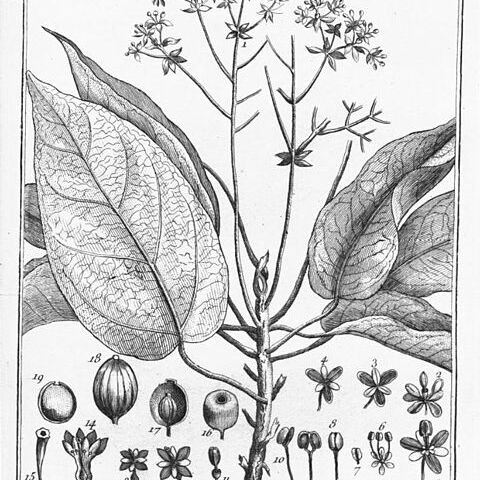Tree up to 30 m high, with buttresses; bark glabrous, shining greyish-white; wood white, with a soft aroma of Apium. Branches fragile and breaking easily. Leaves simple; petiole terete, 6-14(-22) cm long, fleshy at base; blade papery to somewhat leathery, longitudinally folded, elliptic-ovate, 11-20(-30) x 6-14(-25) cm, margin entire, apex 1-2(-3) cm acuminate, base rounded, subcordate or acute, not peltate, only leaves of young plants up to 10 mm peltate, green; at base sub-5-veined, 2-4 pairs of higher secondary veins, veins below loosely pubescent with short glandular and longer straight hairs, otherwise leaves glabrous on both sides. Inflorescence axillary or pseudo-terminal, pubescent, conspicuously ash-grey; peduncle (6-)10-16 cm long; cincinni on secondary or tertiary branches; bracts 0-2, underneath ramifications, variable in shape; bracteoles of male flowers oblong, 5-8 x 3-4 mm. Flower buds ellipsoid or obovoid, 3-5 x 2-3.5 mm. Flowers unisexual. Male flowers: pedicels 2-3 mm long; perianth segments 6, in 2 whorls, whitish, elliptic, 5-6(-7) x 2-2.5 mm, apex and base rounded, densely pubescent; stamens 3, little shorter than perianth, orange-yellow, filaments free, loosely pubescent, anther valves opening to sides; each stamen with 2 glabrous glands. Female flower: pedicel 0-1 mm long; cupule broadly cup-shaped, not constricted, ca. 2 x 2 mm, entire; perianth as in male flower; style little shorter than perianth, thin at base, broader towards stigma, recurved at top, lanate. Fruit pedicel up to 5 mm long. Fruit cupule succulent, red spotted, up to 5.5 x 4 cm, with an almost circular, slightly constricted hole. Drupe brown, ovoid, ca. 3 x 2.4 cm, with 8 longitudinal slightly prominent ribs/grooves, glabrous, apex almost flat, with rounded umbo; cotyledons ruminate, connate.
More
Tree up to 30 m high, with buttresses; bark glabrous, shining greyish-white; wood white, with a soft aroma of Apium. Branches fragile and breaking easily. Leaves simple; petiole terete, 6-14(-22) cm long, fleshy at base; blade papery to somewhat leathery, longitudinally folded, elliptic-ovate, 11-20(-30) x 6-14(-25) cm, margin entire, apex 1-2(-3) cm acuminate, base rounded, subcordate or acute, not peltate, only leaves of young plants up to 10 mm peltate, green; at base sub-5-veined, 2-4 pairs of higher secondary veins, veins below loosely pubescent with short glandular and longer straight hairs, otherwise leaves glabrous on both sides. Inflorescence axillary or pseudo-terminal, pubescent, conspicuously ash-grey; peduncle (6-)10-16 cm long; cincinni on secondary or tertiary branches; bracts 0-2, underneath ramifications, variable in shape; bracteoles of male flowers oblong, 5-8 x 3-4 mm. Flower buds ellipsoid or obovoid, 3-5 x 2-3.5 mm. Flowers unisexual. Male flowers: pedicels 2-3 mm long; perianth segments 6, in 2 whorls, whitish, elliptic, 5-6(-7) x 2-2.5 mm, apex and base rounded, densely pubescent; stamens 3, little shorter than perianth, orange-yellow, filaments free, loosely pubescent, anther valves opening to sides; each stamen with 2 glabrous glands. Female flower: pedicel 0-1 mm long; cupule broadly cup-shaped, not constricted, ca. 2 x 2 mm, entire; perianth as in male flower; style little shorter than perianth, thin at base, broader towards stigma, recurved at top, lanate. Fruit pedicel up to 5 mm long. Fruit cupule succulent, red spotted, up to 5.5 x 4 cm, with an almost circular, slightly constricted hole. Drupe brown, ovoid, ca. 3 x 2.4 cm, with 8 longitudinal slightly prominent ribs/grooves, glabrous, apex almost flat, with rounded umbo; cotyledons ruminate, connate.
Uses: The light and strong wood is traded and used as timber. The Galibis and the Bush-negros use the wood the way we use a tinder/fire lighter. The flowers and the fruit, especially the kernel are used by the Garipons (coming from Pará, Brazil) and by some people from Cayenne to make purgative emulsions. The Palikur use emulsions from the flowers and the fruit against whooping cough, for which the local name is 'maoksikan', which means 'cry of the howler monkey'.
More
Uses: The light and strong wood is traded and used as timber. The Galibis and the Bush-negros use the wood the way we use a tinder/fire lighter. The flowers and the fruit, especially the kernel are used by the Garipons (coming from Pará, Brazil) and by some people from Cayenne to make purgative emulsions. The Palikur use emulsions from the flowers and the fruit against whooping cough, for which the local name is 'maoksikan', which means 'cry of the howler monkey'.

